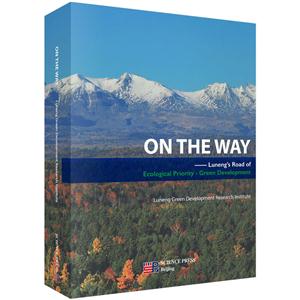在路上——鲁能生态优先绿色发展探索与未来(英文版)
目录
ContentsForeword: It’s TimePart I Why China needs Ecological Priority and Green DevelopmentChapter 1 Why green development 31.1 Crisis caused by human population explosion and industrial development 31.2 Biodiversity: rapid loss is due to various crisis 61.2.1 What is biodiversity? 61.2.2 The rapid loss of species on the earth 8Chapter 2 Why ecological priority is an essential part of green development 122.1 Ecosystem services 122.1.1 Provisioning services 132.1.2 Regulating services 142.1.3 Cultural services 152.1.4 Supporting services 172.2 Nature is a treasure for humanity 19Chapter 3 Why biodiversity is being lost? 203.1 Habitat loss and fragmentation 203.1.1 Ecological damage from agriculture development 213.1.2 Land reclamation 213.1.3 Pollution 223.1.4 Dams and water diversions 223.2 Over exploitation of resources 223.3 The spread of invasive alien species 243.4 Global warming 253.4.1 Observed and projected changes of global climate change 253.4.2 Observed impacts, vulnerability, and exposure 273.4.3 Impacts of climate change on biodiversity 283.4.4 Global climate change and biological invasion 303.4.5 Climate change and wildlife diseases 30Part II Luneng’s Focuses on The Way of Green DevelopmentChapter 4 Habitat conservation 384.1 Ecosystem approach 384.2 Establishing protected areas 404.3 The need for connectivity 434.4 Protecting wetlands 454.4.1 Lakes 464.4.2 Reservoirs 464.4.3 Ponds and ditches 464.4.4 Coastal habitats 464.4.5 Marine habitats 464.4.6 River catchments 474.6 Minimizing damage while constructing 48Chapter 5 Species management 495.1 Recognizing key species to ecosystem services 495.1.1 Water purifi cation service 505.1.2 Pollinating agents 515.1.3 Seed dispersers 525.2 Captive breeding and reintroduction 535.2.1 Reintroductions 535.2.2 Re-stocking 545.3 Managing wild animals 545.3.1 Controlling herbivores 545.3.2 Managing top predators 545.3.3 Reducing alien or undesirable predatory fish 545.3.4 Encouraging birds 555.3.5 Encouraging insects 565.3.6 Encouraging natural pest control 595.3.7 Special needs of migrating species 595.3.8 Greatly reducing wildlife consumption 61Chapter 6 Restoration of degraded landscapes 636.1 Restoring degraded ecosystems 656.1.1 Principles of restoring vegetation 656.1.2 Promoting local species and controlling alien species introduction 666.1.3 Returning steep farms to forest 676.1.4 Grasslands and fi re management 696.1.5 Nursery establishment 706.2 Restoring and creating wetlands and ponds 716.2.1 Ensuring healthy waterways 726.2.2 Creating a pond 736.2.3 Managing water levels 746.2.4 Fire prevention reporting and fighting 75Chapter 7 Towards greener farming-the eco-agriculture approach 767.1 Decoupling food production from environmental degradation and resource depletion 767.2 Diverse modes of eco-agriculture in the World 787.2.1 Eco-agriculture of Australia 797.2.2 Natural agriculture of Japan 797.2.3 Sustainable agriculture of USA 807.2.4 Eco-agriculture of Germany 807.2.5 Permaculture and biodynamic agriculture 807.2.6 Global governmental support to eco-agriculture 817.3 China is at the turning point to eco-agriculture 827.3.1 Three phases of agriculture development in China 827.3.2 China strategy of eco-agriculture 827.3.3 Eco-agriculture development modes in China 847.3.4 Challenges facing eco-agriculture in China 907.3.5 Misunderstanding eco-agriculture 917.4 Case study of eco-agriculture development in Shuanghe village, Dongxi town-ship, Jianyang, Sichuan 927.4.1 Reasonable intercropping and relaycropping 937.4.2 Straw mulching 937.4.3 Comprehensive utilization of methane slurry 947.4.4 Rational management of weeds 957.4.5 Protecting soil scientifi cally 967.4.6 Diseases and pests subject to nature 977.4.7 Notices for cooperatives seeking development of eco-agriculture 99Chapter 8 Ecotourism 1008.1 Ecotourism is in the mainstream to support sustainable development of international 1008.1.1 Defi nition of ecotourism 1008.1.2 Connotations of ecotourism 1018.1.3 Types of ecotourism 1028.1.4 Ecotourism promoting local culture and community development 1048.1.5 Ecotourism is a new business format 1058.2 The concept of ecotourism is well developed internationally 1078.2.1 Development phases of international ecotourism 1078.2.2 Best practices of ecotourism 1088.2.3 Ecotourism as a national strategy in many countries 1118.2.4 International ecotourism organizations moving toward specialization 1128.3 Protected area ecotourism in China 1128.3.1 China ecotourism is actively conducted in protected areas 1128.3.2 Ecotourism is develo
封面

书名:在路上——鲁能生态优先绿色发展探索与未来(英文版)
作者:Luneng green develop
页数:286页
定价:¥298.0
出版社:科学出版社
出版日期:2017-01-01
ISBN:9787030528513
PDF电子书大小:51MB 高清扫描完整版
